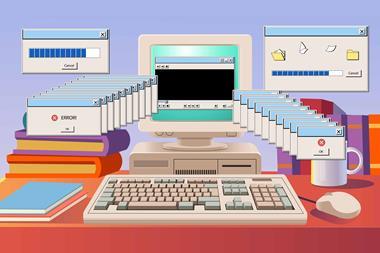How technology can help us run our labs more efficiently

In a rapidly evolving world of digitalisation and industry 4.0, many labs are in danger of being left behind. Which is surprising when you think about it. I mean, technology is our thing. 3D printed reactors, atomic force microscopy of single molecules, organic synthesis via AI – these are pretty amazing achievements. But beyond specialised instrumentation, it’s incredible how pedestrian we still are when it comes to running our labs.
Most people get the value of going digital. Consider the advantages over the traditional petrol gauge, for example: I know exactly how many miles I have left and I can use this information to make more informed decisions. But industry 4.0 means taking things to the next level: connecting multiple systems and allowing information to flow between them. Linking the digital petrol gauge to a satnav will allow predictions to be made around whether you can make it to certain destinations and even auto-direct you to a petrol station if needed. This sort of connectivity brings the real opportunities.
Integrated approaches in the lab are already out there. Automated ordering systems can replenish chemicals or consumables when stocks are low. Intelligent dosing platforms maintain reaction conditions indefinitely. Continuous crystallisers produce particles with perfect attributes every time without fail. But it’s the minority who are taking advantage.
The phrase ‘lab of the future’ likely holds a different meaning depending on who you ask, which could be part of the reason for the slow uptake. Going fully paperless, a laboratory information management system that actually works, lab users equipped with augmented reality headsets, automation, collaborative robots, PPE entry scanners, digital twins of lab equipment, internet of things, QR codes with standard operating procedures and remote support: the list goes on and on.
What you implement should come down to what you are actually looking for from your lab. If throughput is important, then investing in automation makes sense. If your lab is regulated, a well-managed electronic lab management system to keep track of calibrations and certification will probably save you a lot of time. If your chemical store is bursting with items, a digital inventory is a good idea. I’ve personally been involved in implementing all three of these examples. For the latter, not only has it saved precious space, but the savings are easily into the thousands of pounds per year due the possibility of sharing chemicals and individuals not re-ordering materials because they’ve no idea what’s already in stock.
Cost will inevitably be a huge factor. Most suppliers will be able to offer free trials for software, sometimes even hardware too, and these are worth exploring before expensive commitments are made. Being part of a community forum, like a Royal Society of Chemistry interest group, where you can discuss pros and cons and share experiences with like-minded individuals, is also a good idea.
The introduction of robotics doesn’t mean that P45s are on the cards
But before the full benefits are felt, implementing things like automation will require skillsets which you didn’t have before. How are these gaps going to be filled? This is something that shouldn’t be underestimated. Inundating people with lots of different systems can also be a source of friction and it’s well worth investigating overarching options which cover multiple aspects. This will help with training too.
It’s worth bearing in mind that there are people out there who are uneasy with these technology advancements. They fear chemists becoming redundant due to automation, or student knowledge or creativity being compromised by smarter equipment, to give just a couple of examples: ‘I can’t even use Matlab or Python, that means I’m going to be left behind, right?’ The communication of such advancements needs to be managed properly. For example, it needs to be made clear that the introduction of robotics doesn’t mean that P45s are on the cards – instead, a bit of upskilling will be required to manage new capabilities. At the end of the day, humans will always remain in the driving seat.
Through all of this, one thing’s for sure. To ignore the opportunities is a folly, as we need to keep up with our colleagues across industry, academia and the world. Significant increases in lab productivity have already been demonstrated. The uptake of generative AI systems such as ChatGPT is unprecedented and we need to embrace this. Keep in mind that the expectations of younger generations of staff and students is high as we are competing with their own digitalised home environments.
And as we are trying to get to grips with industry 4.0, people are already talking about industry 5.0, which complements its predecessor by including a human-centric approach. An example of this would be a lab where robots and humans are working together. Now is the time to act, if you aren’t doing so already, otherwise you will be left behind, in a trail of digital dust.












No comments yet